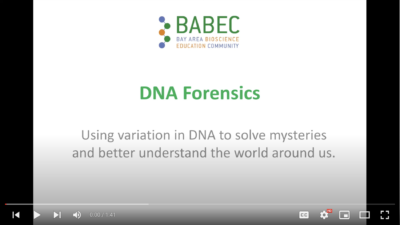Curricula
 DNA Forensics for Exoneration
DNA Forensics for Exoneration
In this lesson, students explore DNA fingerprinting through the true case of Darvin Castro Santos, who was wrongfully convicted of robbery in 2012 and was exonerated in 2021, in part by newly analyzed DNA evidence. After learning about the work of the National Registry of Exonerations and the specifics of Darvin’s case, students use restriction digest and gel electrophoresis to determine whether or not Darvin’s DNA was at the crime scene. The resources for our previous lesson, “”The Case of the Missing Klay Thompson Jersey”” are available under ‘Resources’.
The online version of this lesson follows the Klay Thompson scenario and includes point of view videos for the lab portion. Students use sample results to write a claim about whose DNA was at the scene of the crime and support it with evidence and reasoning.
Learning Objectives
- Describe how DNA was used to exonerate Darvin Castro Santos, who was wrongfully convicted of robbery in 2009.
- Explain how restriction enzymes and gel electrophoresis can be used to create unique DNA fingerprints between individuals
Prior Knowledge
- Getting Started Series Parts 1-3 from BABEC to learn about DNA extraction, Micropipetting, and gel electrophoresis
- Variation in DNA sequence (order of bases) exists among humans and other organisms
In order to access any Curriculum resource, please or if you haven't already done so.
Disciplinary Core Ideas:
LS3.A – Inheritance of Traits
“…not all DNA codes for a protein…” The regions the restriction enzymes cut vary among individuals and typically do not code for a protein
LS3.B – Inheritance of Traits
“…distribution of traits on genetic and environmental factors”
Science and Engineering Practices:
- Planning and Carrying out Investigations
- Analyzing and Intercepting Data Patterns
In order to access any Curriculum resource, please or if you haven't already done so.


